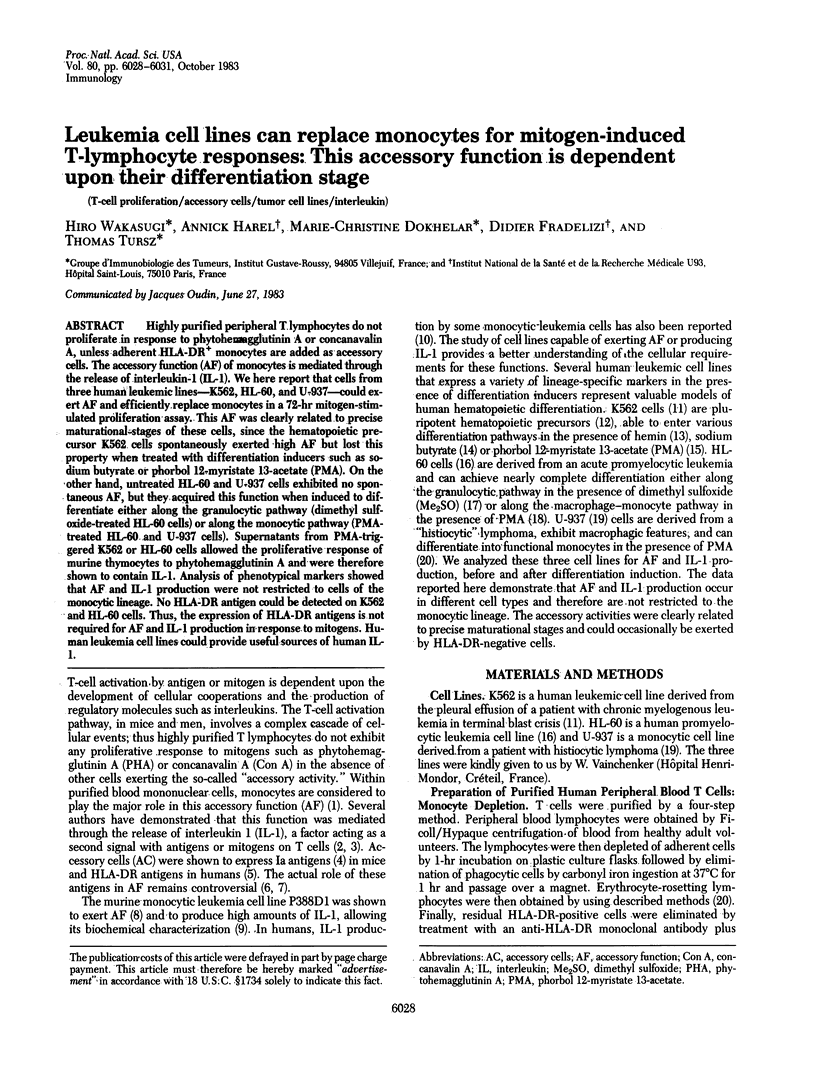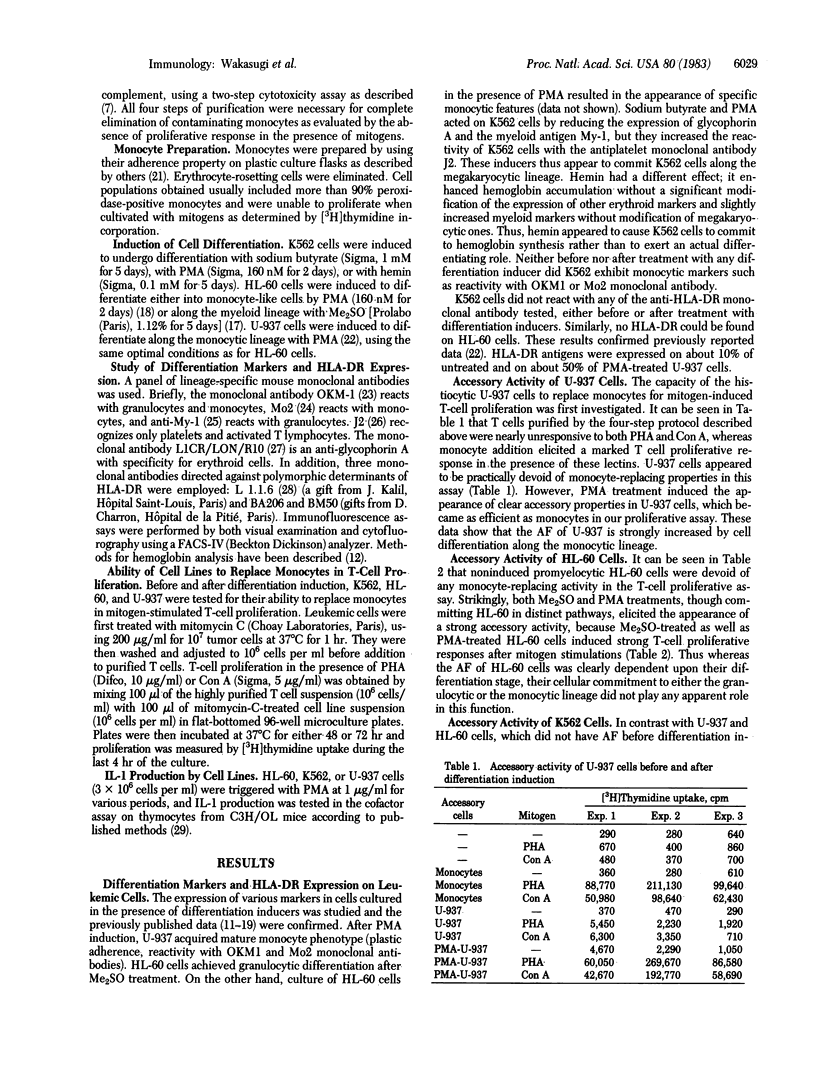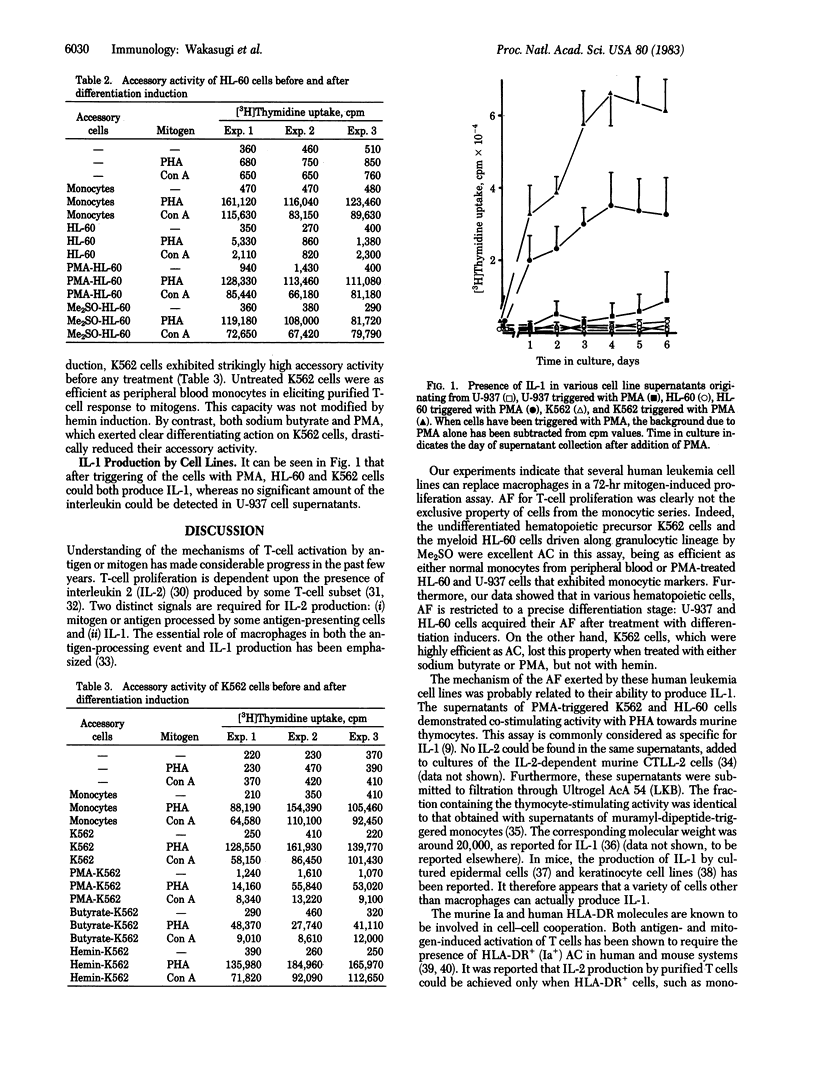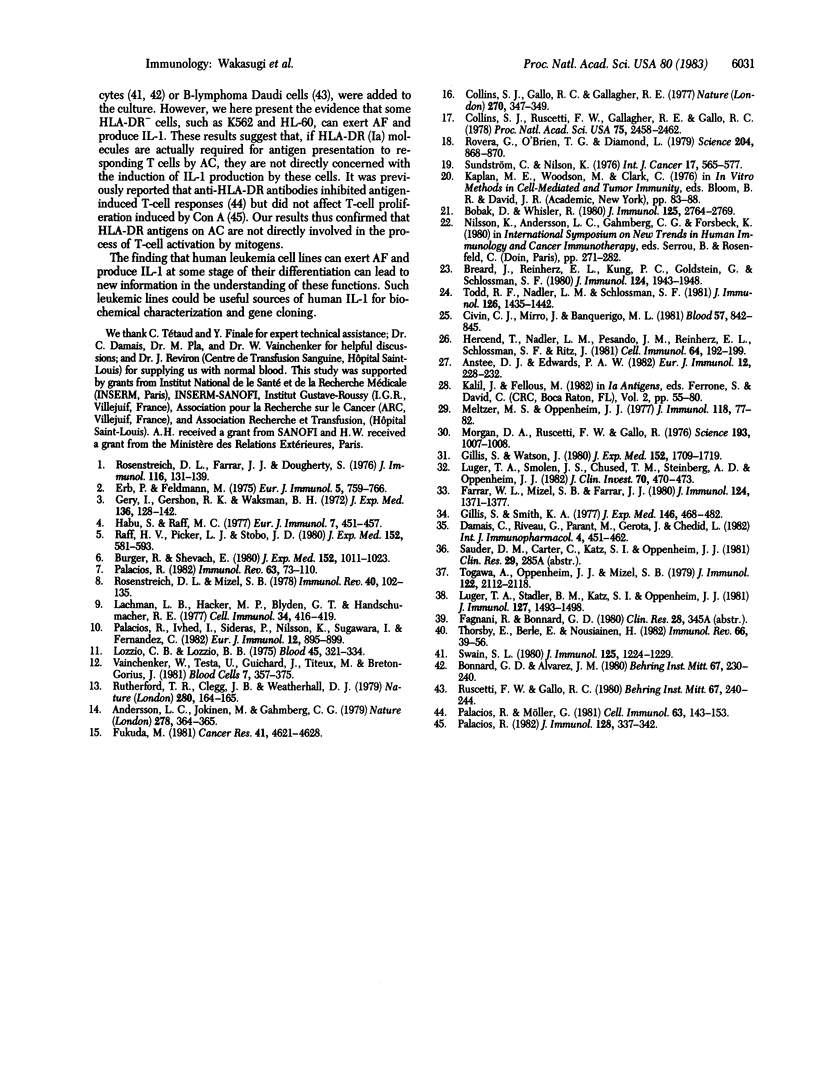Abstract
Highly purified peripheral T lymphocytes do not proliferate in response to phytohemagglutinin A or concanavalin A, unless adherent HLA-DR+ monocytes are added as accessory cells. The accessory function (AF) of monocytes is mediated through the release of interleukin-1 (IL-1). We here report that cells from three human leukemic lines--K562, HL-60, and U-937--could exert AF and efficiently replace monocytes in a 72-hr mitogen-stimulated proliferation assay. This AF was clearly related to precise maturational stages of these cells, since the hematopoietic precursor K562 cells spontaneously exerted high AF but lost this property when treated with differentiation inducers such as sodium butyrate or phorbol 12-myristate 13-acetate (PMA). On the other hand, untreated HL-60 and U-937 cells exhibited no spontaneous AF, but they acquired this function when induced to differentiate either along the granulocytic pathway (dimethyl sulfoxide-treated HL-60 cells) or along the monocytic pathway (PMA-treated HL-60 and U-937 cells). Supernatants from PMA-triggered K562 or HL-60 cells allowed the proliferative response of murine thymocytes to phytohemagglutinin A and were therefore shown to contain IL-1. Analysis of phenotypical markers showed that AF and IL-1 production were not restricted to cells of the monocytic lineage. No HLA-DR antigen could be detected on K562 and HL-60 cells. Thus, the expression of HLA-DR antigens is not required for AF and IL-1 production in response to mitogens. Human leukemia cell lines could provide useful sources of human IL-1.
Full text
PDF



Selected References
These references are in PubMed. This may not be the complete list of references from this article.
- Andersson L. C., Jokinen M., Gahmberg C. G. Induction of erythroid differentiation in the human leukaemia cell line K562. Nature. 1979 Mar 22;278(5702):364–365. doi: 10.1038/278364a0. [DOI] [PubMed] [Google Scholar]
- Anstee D. J., Edwards P. A. Monoclonal antibodies to human erythrocytes. Eur J Immunol. 1982 Mar;12(3):228–232. doi: 10.1002/eji.1830120311. [DOI] [PubMed] [Google Scholar]
- Bobak D., Whisler R. Human B lymphocyte colony responses. I. General characteristics and modulation by monocytes. J Immunol. 1980 Dec;125(6):2764–2769. [PubMed] [Google Scholar]
- Breard J., Reinherz E. L., Kung P. C., Goldstein G., Schlossman S. F. A monoclonal antibody reactive with human peripheral blood monocytes. J Immunol. 1980 Apr;124(4):1943–1948. [PubMed] [Google Scholar]
- Burger R., Shevach E. M. Monoclonal antibodies to guinea pig Ia antigens. II. Effect on alloantigen-, antigen-, and mitogen-induced T lymphocyte proliferation in vitro. J Exp Med. 1980 Oct 1;152(4):1011–1023. doi: 10.1084/jem.152.4.1011. [DOI] [PMC free article] [PubMed] [Google Scholar]
- Civin C. I., Mirro J., Banquerigo M. L. My-1, new myeloid-specific antigen identified by a mouse monoclonal antibody. Blood. 1981 May;57(5):842–845. [PubMed] [Google Scholar]
- Collins S. J., Gallo R. C., Gallagher R. E. Continuous growth and differentiation of human myeloid leukaemic cells in suspension culture. Nature. 1977 Nov 24;270(5635):347–349. doi: 10.1038/270347a0. [DOI] [PubMed] [Google Scholar]
- Collins S. J., Ruscetti F. W., Gallagher R. E., Gallo R. C. Terminal differentiation of human promyelocytic leukemia cells induced by dimethyl sulfoxide and other polar compounds. Proc Natl Acad Sci U S A. 1978 May;75(5):2458–2462. doi: 10.1073/pnas.75.5.2458. [DOI] [PMC free article] [PubMed] [Google Scholar]
- Damais C., Riveau G., Parant M., Gerota J., Chedid L. Production of lymphocyte activating factor in the absence of endogenous pyrogen by rabbit or human leukocytes stimulated by a muramyl dipeptide derivative. Int J Immunopharmacol. 1982;4(5):451–462. doi: 10.1016/0192-0561(82)90020-0. [DOI] [PubMed] [Google Scholar]
- Erb P., Feldmann M. The role of macrophages in the generation of T helper cells. III. Influence of macrophage-derived factors in helper cell induction. Eur J Immunol. 1975 Nov;5(11):759–766. doi: 10.1002/eji.1830051106. [DOI] [PubMed] [Google Scholar]
- Farrar W. L., Mizel S. B., Farrar J. J. Participation of lymphocyte activating factor (Interleukin 1) in the induction of cytotoxic T cell responses. J Immunol. 1980 Mar;124(3):1371–1377. [PubMed] [Google Scholar]
- Fukuda M. Tumor-promoting phorbol diester-induced specific changes in cell surface glycoprotein profile of K562 human leukemic cells. Cancer Res. 1981 Nov;41(11 Pt 1):4621–4628. [PubMed] [Google Scholar]
- Gery I., Gershon R. K., Waksman B. H. Potentiation of the T-lymphocyte response to mitogens. I. The responding cell. J Exp Med. 1972 Jul 1;136(1):128–142. doi: 10.1084/jem.136.1.128. [DOI] [PMC free article] [PubMed] [Google Scholar]
- Gillis S., Smith K. A. In vitro generation of tumor-specific cytotoxic lymphocytes. Secondary allogeneic mixed tumor lymphocyte culture of normal murine spleen cells. J Exp Med. 1977 Aug 1;146(2):468–482. doi: 10.1084/jem.146.2.468. [DOI] [PMC free article] [PubMed] [Google Scholar]
- Gillis S., Watson J. Biochemical and biological characterization of lymphocyte regulatory molecules. V. Identification of an interleukin 2-producing human leukemia T cell line. J Exp Med. 1980 Dec 1;152(6):1709–1719. doi: 10.1084/jem.152.6.1709. [DOI] [PMC free article] [PubMed] [Google Scholar]
- Habu S., Raff M. C. Accessory cell dependence of lectin-induced proliferation of mouse T lymphocytes. Eur J Immunol. 1977 Jul;7(7):451–457. doi: 10.1002/eji.1830070710. [DOI] [PubMed] [Google Scholar]
- Hercend T., Nadler L. M., Pesando J. M., Reinherz E. L., Schlossman S. F., Ritz J. Expression of a 26,000-dalton glycoprotein on activated human T cells. Cell Immunol. 1981 Oct;64(1):192–199. doi: 10.1016/0008-8749(81)90470-6. [DOI] [PubMed] [Google Scholar]
- Lachman L. B., Hacker M. P., Blyden G. T., Handschumacher R. E. Preparation of lymphocyte-activating factor from continuous murine macrophage cell lines. Cell Immunol. 1977 Dec;34(2):416–419. doi: 10.1016/0008-8749(77)90263-5. [DOI] [PubMed] [Google Scholar]
- Lozzio C. B., Lozzio B. B. Human chronic myelogenous leukemia cell-line with positive Philadelphia chromosome. Blood. 1975 Mar;45(3):321–334. [PubMed] [Google Scholar]
- Luger T. A., Smolen J. S., Chused T. M., Steinberg A. D., Oppenheim J. J. Human lymphocytes with either the OKT4 or OKT8 phenotype produce interleukin 2 in culture. J Clin Invest. 1982 Aug;70(2):470–473. doi: 10.1172/JCI110637. [DOI] [PMC free article] [PubMed] [Google Scholar]
- Luger T. A., Stadler B. M., Katz S. I., Oppenheim J. J. Epidermal cell (keratinocyte)-derived thymocyte-activating factor (ETAF). J Immunol. 1981 Oct;127(4):1493–1498. [PubMed] [Google Scholar]
- Meltzer M. S., Oppenheim J. J. Bidirectional amplification of macrophage-lymphocyte interactions: enhanced lymphocyte activation factor production by activated adherent mouse peritoneal cells. J Immunol. 1977 Jan;118(1):77–82. [PubMed] [Google Scholar]
- Morgan D. A., Ruscetti F. W., Gallo R. Selective in vitro growth of T lymphocytes from normal human bone marrows. Science. 1976 Sep 10;193(4257):1007–1008. doi: 10.1126/science.181845. [DOI] [PubMed] [Google Scholar]
- Palacios R. Concanavalin A triggers T lymphocytes by directly interacting with their receptors for activation. J Immunol. 1982 Jan;128(1):337–342. [PubMed] [Google Scholar]
- Palacios R., Ivhed I., Sideras P., Nilsson K., Sugawara I., Fernandez C. Accessory function of human tumor cell lines. I. Production of interleukin 1 by the human histiocytic lymphoma cell line U-937. Eur J Immunol. 1982 Oct;12(10):895–899. doi: 10.1002/eji.1830121018. [DOI] [PubMed] [Google Scholar]
- Palacios R. Mechanism of T cell activation: role and functional relationship of HLA-DR antigens and interleukins. Immunol Rev. 1982;63:73–110. doi: 10.1111/j.1600-065x.1982.tb00412.x. [DOI] [PubMed] [Google Scholar]
- Palacios R., Möller G. HLA-DR antigens render resting T cells sensitive to interleukin-2 and induce production of the growth factor in the autologous mixed lymphocyte reaction. Cell Immunol. 1981 Sep 1;63(1):143–153. doi: 10.1016/0008-8749(81)90035-6. [DOI] [PubMed] [Google Scholar]
- Raff H. V., Picker L. J., Stobo J. D. Macrophage heterogeneity in man. A subpopulation of HLA-DR-bearing macrophages required for antigen-induced T cell activation also contains stimulators for autologous-reactive T cells. J Exp Med. 1980 Sep 1;152(3):581–593. doi: 10.1084/jem.152.3.581. [DOI] [PMC free article] [PubMed] [Google Scholar]
- Rosenstreich D. L., Farrar J. J., Dougherty S. Absolute macrophage dependency of T lymphocyte activation by mitogens. J Immunol. 1976 Jan;116(1):131–139. [PubMed] [Google Scholar]
- Rosenstreich D. L., Mizel S. B. The participation of macrophages and macrophage cell lines in the activation of T lymphocytes by mitogens. Immunol Rev. 1978;40:102–135. doi: 10.1111/j.1600-065x.1978.tb00403.x. [DOI] [PubMed] [Google Scholar]
- Rovera G., O'Brien T. G., Diamond L. Induction of differentiation in human promyelocytic leukemia cells by tumor promoters. Science. 1979 May 25;204(4395):868–870. doi: 10.1126/science.286421. [DOI] [PubMed] [Google Scholar]
- Rutherford T. R., Clegg J. B., Weatherall D. J. K562 human leukaemic cells synthesise embryonic haemoglobin in response to haemin. Nature. 1979 Jul 12;280(5718):164–165. doi: 10.1038/280164a0. [DOI] [PubMed] [Google Scholar]
- Sundström C., Nilsson K. Establishment and characterization of a human histiocytic lymphoma cell line (U-937). Int J Cancer. 1976 May 15;17(5):565–577. doi: 10.1002/ijc.2910170504. [DOI] [PubMed] [Google Scholar]
- Swain S. L. Role of Ia-positive cells in the production of T cell-replacing factors: blocking of factor production with anti-Ia serum. J Immunol. 1980 Sep;125(3):1224–1229. [PubMed] [Google Scholar]
- Thorsby E., Berle E., Nousiainen H. HLA-D region molecules restrict proliferative T cell responses to antigen. Immunol Rev. 1982;66:39–56. doi: 10.1111/j.1600-065x.1982.tb00433.x. [DOI] [PubMed] [Google Scholar]
- Todd R. F., 3rd, Nadler L. M., Schlossman S. F. Antigens on human monocytes identified by monoclonal antibodies. J Immunol. 1981 Apr;126(4):1435–1442. [PubMed] [Google Scholar]
- Togawa A., Oppenheim J. J., Mizel S. B. Characterization of lymphocyte-activating factor (LAF) produced by human mononuclear cells: biochemical relationship of high and low molecular weight forms of LAF. J Immunol. 1979 May;122(5):2112–2118. [PubMed] [Google Scholar]
- Vainchenker W., Testa U., Guichard J., Titeux M., Breton-Gorius J. Heterogeneity in the cellular commitment of a human leukemic cell line: K 562. Blood Cells. 1981;7(2):357–375. [PubMed] [Google Scholar]


